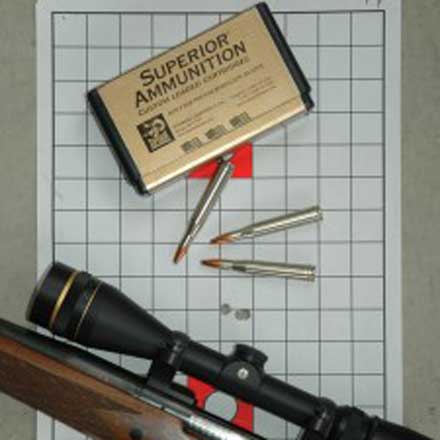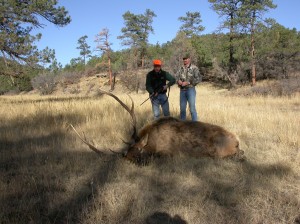
I have been a fan of the fast .30-calibers for many years. There are few tools more versatile, or equally well suited to a wide variety of game and conditions. Of what we think of as “magnum .30s” I suppose I have used the .300 Weatherby Magnum the most, but I’ve used the .300 Winchester Magnum quite a bit, and I’ve at least dabbled with the full range of new .30-caliber magnums, including short and long Lazzeroni cartridges, the .300 Remington Ultra Mag and its short-action brother, the .300 Winchester Short Magnum, and the new kid on the block, the .300 Ruger Compact Magnum. I like them all, and all have all the attributes of the high-velocity .30-caliber: Flat trajectory and wind-bucking capability; high downrange energy; and ability to use the great wealth of .30-caliber bullets. Perhaps oddly, I am only a fairly recent fan of the granddaddy of them all, the .300 Holland & Holland Magnum.
Nobody needs multiple fast .30s, but I have had multiples for decades. So, but for my buddy Geoff Miller, I might never have used the .300 H&H. It slipped out of the limelight at least 30 years ago, and today there are almost no standard rifles so chambered, and very few factory loads still available. Geoff Miller is the proprietor of John Rigby and Company, late of England, now of our little town of Paso Robles, California—and the .300 H&H is his favorite all-around hunting cartridge. A few years ago he insisted on rebarreling a left-hand Remington Model 700 to that cartridge for me. Geoff knows how to make this cartridge shoot, and a match-grade Pac-Nor barrel didn’t hurt. So, somewhat belatedly, I learned that this grand old cartridge still has a lot to offer.
The .300 H&H Magnum was introduced by Holland and Holland in 1925, originally called the “Super .30.” It is based on the .375 H&H case necked down to take a .308-inch bullet. It was winner for Holland & Holland, and almost immediately was offered by American custom rifle makers. Within a year the old Western Cartridge Company offered an American factory load, but the cartridge didn’t become really popular until the mid-1930s. It got a huge boost when Ben Comfort used it to win the Wimbledon Cup in 1935—but its real break came in 1937, when it was offered as one of the initial chamberings in the Winchester Model 70, the rifle that would soon become the world’s pre-eminent bolt action sporting rifle.
For the next 26 years the .300 H&H was the...
world standard fast magnum, revered in Africa and almost as popular among hunters in the American West. Then, in 1963, Winchester introduced the shorter, sharper-shouldered, more modern-looking .300 Winchester Magnum, and the sun began to set on the .300 H&H. On the surface this makes sense. The .300 H&H is an archaic design, with a lot of body taper and a gently sloping shoulder. Its 2.850-inch case requires a full-length (.375 H&H-length) action, while the .300 Winchester Magnum produces similar performance from a standard-length (.30-06-length) action. Too, the faster .300 Weatherby Magnum, developed in 1944, gained steadily in popularity through the 1950s and 60s. Roy Weatherby’s .300 is just one of many “improved” versions of the .300 H&H, with less body taper, sharper shoulder, and a whole lot more case capacity.

Then, in the 1990s, we had a whole new crew of fast .30s, mostly unbelted, modern as tomorrow. It was 2003 when I first used the .300 H&H, partly out of curiosity, partly as a favor to a friend, but in the self-righteous belief that this old-timer had very little to offer. It turns out I was wrong!
That tapered case does look old-fashioned, but it allows exceptionally smooth, trouble-free feeding. As far as accuracy goes, the H&H can be spectacular. Mine certainly is. It has produced a lot of superb 100-yard groups with a lot of different bullets and loads, but I think its very best group was shot with 150-grain Sierras loaded by Larry Barnett at Superior. It was a 1 ½-inch group at 400 yards.
Velocity is a bit of an issue. The very few factory loads still available are very conservative, almost certainly due to concerns about the 80-year-old rifles they might be used in. The standard load today is generally a 180-grain bullet at 2880 feet per second. There are a few .30-06 factory loads that equal this velocity, and all .300 Winchester Magnum loads beat it.
So, realistically, if you shoot factory loads it would be impractical to build up a new .300 H&H. However, current factory loads do not offer a full measure of the cartridge’s capability. In the 26-inch barrel of my .300 H&H, using IMR 4831 in handloads, or as loaded by Superior, I get...
3350 fps from a 150-grain bullet, 3100 from a 180-grain bullet, and over 2900 from a 200-grain bullet. All with wonderful accuracy and smooth feeding. There are several .30-calibers that are faster, and others that fit into more compact actions, but with good loads the old H&H holds its own quite well.

Since 2003 I’ve used it enough to know that I like it and I trust it. The first hunt I took it on was a desert sheep hunt in Sonora in 2003. The shot I drew was about 330 yards, sharply uphill, a much more difficult shot than I would have liked. The 150-grain Sierra hit exactly where I wanted, and the ram went nowhere. Since then I’ve used it for elk, a variety of African game, and a couple of hunts in New Zealand and Australia. Uncharacteristically, I’ve bypassed the 180-grain bullets that I tend to love, instead using 150-grain bullets for lighter game and 200-grain bullets for bigger animals. It has never let me down. Perhaps a new .300 H&H doesn’t make a lot of sense, but if you have an old favorite there’s no reason to retire it—and if you see a deal on a vintage rifle with a good barrel, grab it. There’s still a lot of life left in Holland’s Super .30.